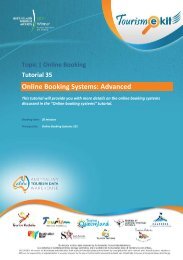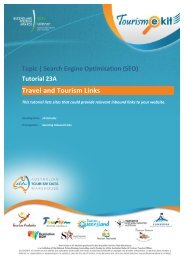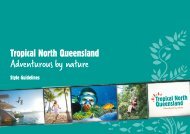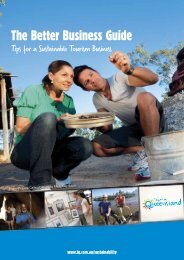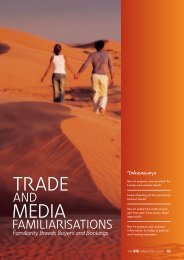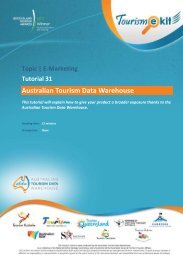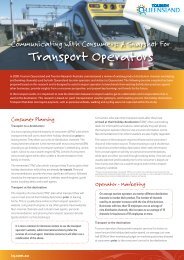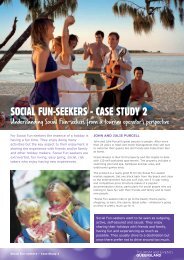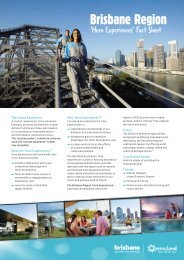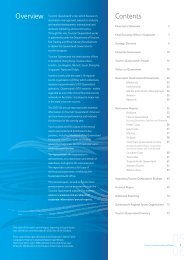Outback Education Handbook PDF - Tourism Queensland
Outback Education Handbook PDF - Tourism Queensland
Outback Education Handbook PDF - Tourism Queensland
You also want an ePaper? Increase the reach of your titles
YUMPU automatically turns print PDFs into web optimized ePapers that Google loves.
Species include at least 54 mammals, 225 birds, 21 amphibians and<br />
110 reptiles. The native fauna has adapted to the open, seasonally arid<br />
grasslands. Birds are either seed or insect-eating ground dwellers such as<br />
the little button-quail, Australian bustard and singing bushlark, or migratory,<br />
visiting in the wet season to breed before the dry sets in again. Reptiles<br />
and small mammals live in the soil cracks and some mammals found only<br />
in this habitat include the Julia Creek Dunnart, narrow-nosed planigale, and<br />
Forrest’s mouse. Rare reptiles such as the bearded dragon, Collett’s snake<br />
or ‘Downs Tiger’ and the skink are also native to the region.<br />
Desert Uplands<br />
The Desert Uplands lie in central northern <strong>Queensland</strong>, straddling the<br />
Great Dividing Range between Blackall and Pentland. Sandstone ranges<br />
and sand plains dominate this bioregion and coal deposits can be found<br />
deep down. The Desert Uplands cover 7,032,297 hectares (4 per cent)<br />
of <strong>Queensland</strong>. Although not a true desert, the bioregion has desert-like<br />
characteristics. With a low rainfall the sandy soils are relatively infertile.<br />
Most of the Desert Uplands’ biodiversity appears to be intact, however<br />
of the region’s 21 rare flora species and 33 fauna species, six species of<br />
fauna - the Edgbaston goby, red goshawk, Gouldian finch, Allan’s lerista,<br />
star finch, and red-finned blue eye - are endangered and one species of<br />
flora - the Eriocaulon carsonii. The major communities of the bioregion<br />
are Barcaldine and Aramac and protected areas include:<br />
n White Mountain National Park<br />
n White Mountain Resource<br />
Reserve<br />
History - Hughenden<br />
First residents: Dalleburra and Jirandali, Kutjala peoples<br />
European exploration: Lt Stokes, 1841<br />
European settlement: 1862<br />
Town gazetted: 1866<br />
n Morrinya National Park<br />
n Forest Den National Park<br />
History highlights:<br />
n First entire Muttaburrasauras dinosaur found in Australia, 1987<br />
n First Bracelet horse race ever run in Australia, 1886<br />
Additional Resources<br />
<strong>Queensland</strong> Natural Resources and Water<br />
www.nrw.qld.gov.au/vegetation/bioregions.html<br />
<strong>Queensland</strong> Environmental Protection<br />
Agency<br />
Source: Wide range of information resources<br />
www.epa.qld.gov.au/nature_conservation/<br />
biodiversity/regional_ecosystems/desert_<br />
uplands/introduction/<br />
www.epa.qld.gov.au/register/p00716bt.pdf<br />
www.epa.qld.gov.au/nature_conservation/<br />
habitats/wetlands/wetland_management_<br />
profiles/wetland_management_profiles__an_<br />
overview/what_are_regional_ecosystems_res/<br />
National Parks Association of <strong>Queensland</strong><br />
Unit 9, 36 Finchley St, Milton QLD 4064<br />
Phone: (07) 3367 0878<br />
www.npaq.org.au/content/view/29/98/<br />
Department Natural Resources and Water<br />
Source: Fact sheets on all environmental<br />
elements related to <strong>Queensland</strong> bioregions<br />
www.nrw.qld.gov.au/factsheets/index.php<br />
Australian Natural Resources Atlas<br />
Source: Information and Fast Fact sheets<br />
www.anra.gov.au/topics/vegetation/pubs/<br />
biodiversity/bio_assess_contents.html<br />
Department of Primary Industries<br />
Source: <strong>Education</strong>al resources<br />
www.dpi.qld.gov.au/cps/rde/dpi/<br />
hs.xsl/4790_8586_ENA_HTML.htm<br />
References<br />
<strong>Queensland</strong> Environmental<br />
Protection Agency<br />
www.epa.qld.gov.au/nature_conservation/<br />
biodiversity/regional_ecosystems/desert_<br />
uplands/introduction/<br />
Further Information<br />
Flinders Discovery Centre<br />
Gray Street, Hughenden QLD 4821<br />
Phone: (07) 4741 1021<br />
Email: info@flinders.qld.gov.au<br />
www.hughenden.com<br />
Classroom Activities<br />
n National Threatened Species Day is held on 7 September each year to encourage the community to help<br />
conserve Australia’s unique native fauna and flora. For more information on how to become involved visit<br />
www.environment.gov.au/biodiversity/threatened/ts-day/index.html<br />
n Become Weed Warriors and start a weed eradication program at your school (www.weedwarriors.net.au)<br />
n Play Weed Wipeout (www.weedscrc.org.au/for_schools/weedwipeout_flash.html)<br />
Best Experience<br />
Porcupine Gorge, via Hughenden<br />
Kennedy Developmental Road (73 kms north of Hughenden), via Hughenden QLD 4821<br />
Cost: Entry to the park is free, however fees apply for camping<br />
Hours: Open 24 hours per day<br />
Contact: Information, access and maps available at www.epa.qld.gov.au/parks_and_forests/find_a_park_or_forest/<br />
Other Points of Interest<br />
n White Mountains National Park, via Hughenden<br />
n Moorrinya National Park, via Hughenden<br />
n Diamantina National Park, via Bedourie<br />
n Boodjamulla (Lawn Hill) National Park, via Gregory<br />
<strong>Queensland</strong>’s <strong>Outback</strong> <strong>Education</strong> <strong>Handbook</strong> | Natural <strong>Outback</strong> 059




